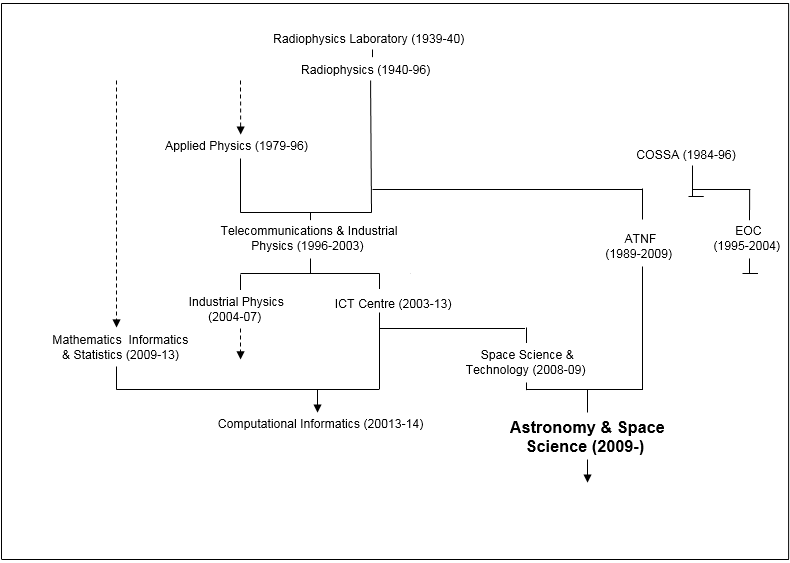Astronomy, Space Science, Information and Communication Technology Divisions
CSIRO’s research into space science had its beginnings around 1944 in the Division of Radiophysics which had been established in 1939 following a secret Cabinet meeting of the Australian Federal Government, of which no records were kept. The meeting approved the setting up of a radar research establishment to aid the World War 2 effort. It was given the cover designation of the CSIR Radiophysics Laboratory. The CSIR Radiophysics Laboratory was granted divisional status in May 1940. Once the war ended the division turned its attention to two main areas: radio astronomy and cloud physics. From 1946 to 1954 scientists and engineers from the CSIRO Division of Radiophysics built a range of radio telescopes at Dover Heights. This then led on to the development of the Parkes telescope, completed in 1961, and the Australian Telescope Compact Array (ATCA) opened in 1988.
The original CSIRO Office of Space Science and Applications (COSSA) was established in 1984 and was part of the Institute of Information and Communication Technologies. The CSIRO Earth Observation Centre (EOC) was established within COSSA in 1995. The EOC structure within COSSA had the nature of a Program in a Division. COSSA and the EOC shared the same Head and had complementary missions in their areas of common interest in space activities and national and international liaison. COSSA ceased operations in 1996 while the activities of EOC concluded in 2003/2004.
The Australian Telescope National Facility was created as a separate Division in January 1989 and operated as such until 1 December 2009, when the ATNF became part of a new Division, CSIRO Astronomy and Space Science (CASS).
In 1996 the Division of Radiophysics merged with the Division of Applied Physics to form the Division of Telecommunication and Industrial Physics, which continued to operate until the middle of 2003 when the Information and Communication Technology Centre (ICT Centre) was created. The ICT Centre split off from the Division of Telecommunication and Industrial Physics, which in turn was renamed the Division of Industrial Physics in 2004. The ICT Centre also included some parts of CSIRO Mathematics, Informatics and Statistics (CMIS) as well as the robotics groups from CSIRO Manufacturing and Infrastructure Technology (CMIT). In 2013 the ICT Centre merged with the Division of Mathematics, Informatics & Statistics to form the Division of Computational Informatics.
CSIRO Space Sciences and Technology was established as a new unit in October 2008. It was initially housed within the ICT Centre (along with NASA Operations). Space Sciences and Technology inherited some of the responsibilities of the old CSIRO Office of Space Science and Applications (COSSA) and the CSIRO Earth Observation Centre (EOC), but was not a direct replacement of those entities.
In December 2009, the new Division, CSIRO Astronomy and Space Science (CASS), was formed which brought together CSIRO’s radio astronomy capabilities (the Australia Telescope National Facility), NASA Operations (including the Canberra Deep Space Communication Complex), CSIRO Space Sciences and Technology; and the CSIRO Boeing Advisor. NASA Operations had had a very diverse history within CSIRO, having been part of a number of Divisions over the years. In July 2014, in a major restructuring of CSIRO when most Divisions were renamed Flagships, CSIRO Astronomy and Space Science did not become a Flagship but remained an independent business unit in the broader grouping of National Facilities and Collections.
History of Astronomy, Space Science, Information and Communication Technology Divisions
Chief of Division/Officer-in-Charge
Iain Collings (Acting, 2014)
| Division | Chief |
| CSIRO Office of Space Science and Applications (COSSA) (1984-96) | Kenneth Gordon McCracken (1984-89) Graham Harris (1989-93) Brian Jerrald Jack Embleton (1993-96) |
| Radiophysics Laboratory (1939-40) | David Forbes Martyn (1939-40) |
| Radiophysics (1940-96) | David Forbes Martyn (1940) Frederick William George White (1940-45) John Noel Briton (1945-46) Edward George (Taffy)Bowen (1946-71) John Paul Wild (1971-78) Harry Clive Minnett (1978-81) Robert Henry Frater (1981-88) Dennis N Cooper (1988-96) |
| Australian Telescope National Facility (1989-2009) | Ronald David Ekers (1989-2003) Brian Boyle (2003-2009) |
| Applied Physics mark II (1979-96) | Frederick John Lehany (1979-80) John Lowke (1980-88) William Roderick Blevin (1988-94) John Collins (1995-96) |
| Telecommunication and Industrial Physics (1996-2004) | Dennis N Cooper (1996-2000) Gerald Neil Haddad (Acting 2000-01) Warren King (2001-02) Gerald Neil Haddad (2002-03) |
| Information and Communication Technology Centre (ICT Centre) (2003-2014) | Alexander Zelinsky (2004-09) Ian Oppermann (2010-13) |
| Mathematics, Informatics and Statistics (2009-14 ) | Louise Ryan (2009-2012) Bronywn Harch (2012-14) |
| Industrial Physics (2004-07) | Gerald Neil Haddad (2002-03) Calum John Drummond (2006-07) |
| Computational Informatics (2013-14) | Bronwyn Harch (2012-14) Iain Collings (Acting, 2014) |
| Space Sciences and Technology (2008-09) | Alexander Zelinsky (2008-09) |
| Astronomy and Space Science (2009- ) | Phillip Diamond (2010-12) Sarah Pearce (Acting 2012-13) Lewis Ball (Director 2013-) |
Sources
• Schedvin CB, Trace K, 1978, Historical Directory of CSIR and CSIRO 1926-1976, CSIRO Publishing.
• Encyclopedia of Australian Science
• CSIRO Communications

